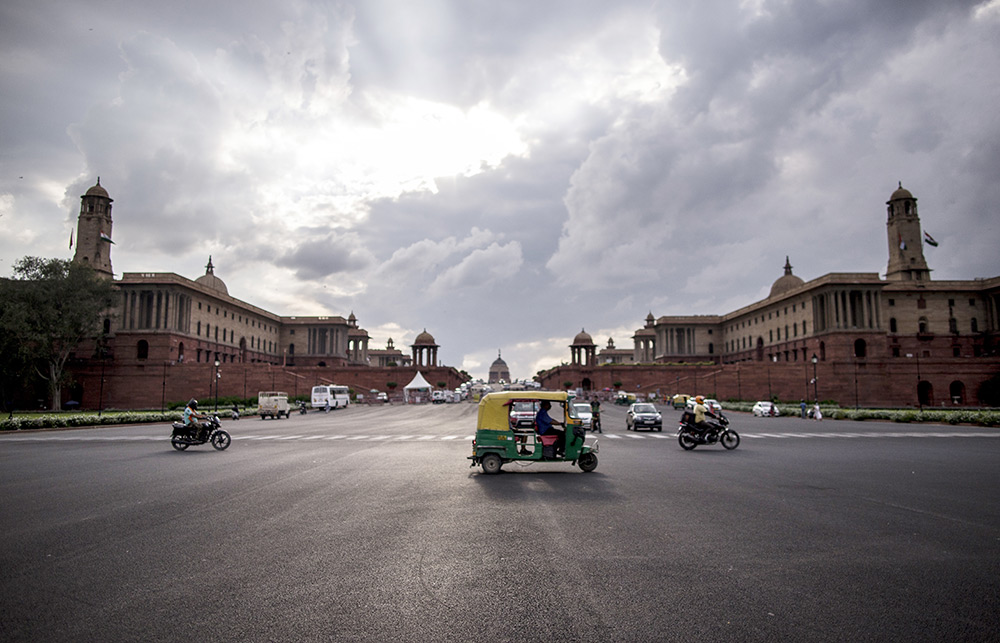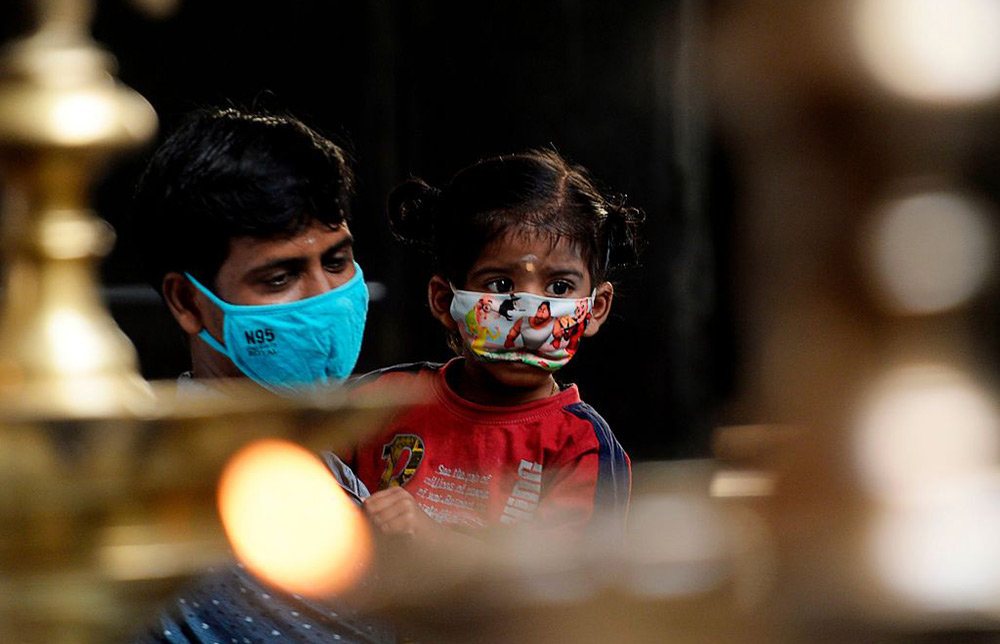今年3月下旬,印度總理納倫德拉·莫迪宣布全國(guó)封鎖21天,以期阻止新冠病毒在13億人口中傳播。那是世界上最嚴(yán)厲的全國(guó)封鎖措施:政府命令居民居家避疫,暫停運(yùn)輸網(wǎng)絡(luò),并關(guān)閉幾乎所有企業(yè)、辦公樓和宗教場(chǎng)所。
印度的封國(guó)抗疫舉措代表了世界范圍內(nèi)各國(guó)政府與公民之間達(dá)成的社會(huì)契約:為減緩新冠疫情傳播、尋求公共衛(wèi)生利益而做出短期經(jīng)濟(jì)犧牲。
但這種犧牲并未換來(lái)目標(biāo)的達(dá)成。
實(shí)際上,與其他國(guó)家相比,印度如今正承受著嚴(yán)重得多的雙重打擊:印度經(jīng)濟(jì)正在經(jīng)歷著該國(guó)自1996年開(kāi)始公布國(guó)內(nèi)生產(chǎn)總值(GDP)數(shù)據(jù)以來(lái)最為嚴(yán)重的衰退,同時(shí)它是全球新冠肺炎確診病例增長(zhǎng)最快的國(guó)家。
“非同尋常的經(jīng)濟(jì)萎縮”
印度政府在8月31日公布,2020年第二季度,該國(guó)GDP較去年同期下跌近24%。這是數(shù)十年來(lái)印度經(jīng)濟(jì)最大一次收縮,也創(chuàng)下全球前五大經(jīng)濟(jì)體中最嚴(yán)重的第二季度滑坡。(美國(guó)經(jīng)濟(jì)在第二季度下跌9.5%。)
印度農(nóng)業(yè)產(chǎn)值在第二季度同比增長(zhǎng)3.4%,但除此之外,其他行業(yè)均形勢(shì)慘淡。建筑業(yè)產(chǎn)值同比下跌50%,制造業(yè)下跌39%,貿(mào)易、酒店和其他服務(wù)業(yè)產(chǎn)值下跌47%。
在疫情爆發(fā)之前,受累于信貸增長(zhǎng)放緩,2018年還是全球增速最快的印度經(jīng)濟(jì)已經(jīng)開(kāi)始走弱。新冠病毒大流行更是加劇了印度經(jīng)濟(jì)的下行。
新加坡國(guó)立大學(xué)南亞研究學(xué)所的高級(jí)研究員阿米滕杜·帕利特說(shuō):“即使與深受新冠大流行影響的其他國(guó)家相比,印度經(jīng)濟(jì)萎縮的程度也是非同尋常的。”
封鎖與開(kāi)放
鑒于印度全國(guó)進(jìn)入封鎖狀態(tài),一定程度上的經(jīng)濟(jì)困難肯定是預(yù)料得到的,但印度施加抗疫出行限制,反而一定程度上促使了疫情的擴(kuò)散,并使任何經(jīng)濟(jì)反彈復(fù)雜化。
莫迪于3月24日晚上8點(diǎn)宣布封國(guó),且封鎖令于當(dāng)晚12點(diǎn)生效,也就是電視通告發(fā)布僅4小時(shí)后。

混亂隨之而來(lái),數(shù)十萬(wàn)計(jì)的農(nóng)民工突然被困在他們務(wù)工的城市,失去了任何收入來(lái)源,也無(wú)處就地避疫。許多人徒步跋涉回到了數(shù)百英里外的農(nóng)村老家,從而促使了新冠病毒在全國(guó)的傳播。
大范圍的失業(yè)和經(jīng)濟(jì)損失迫使印度政府在6月開(kāi)始分階段逐步放松封鎖措施,盡管印度的新增確診病例還在上升。
大約兩個(gè)月后,全國(guó)各地的公共衛(wèi)生系統(tǒng)都因?yàn)樾鹿诓《净颊呒ぴ龆鴳?yīng)接不暇。由于需求者不計(jì)其數(shù),新冠病毒測(cè)試服務(wù)處于稀缺狀態(tài)。國(guó)家層面沒(méi)有要求佩戴口罩的硬性規(guī)定;實(shí)際上,印度衛(wèi)生部只建議有明顯新冠病毒癥狀的患者或照顧可能患有該疾病的人時(shí)才需要戴口罩。
印度的官方新冠病毒確診病例總數(shù)為369萬(wàn),僅次于美國(guó)和巴西;印度新冠病毒致死病例為65,000人。但在浦那、孟買和新德里等城市進(jìn)行的血清樣本調(diào)查表明,新冠病毒的傳播比官方數(shù)據(jù)所展示的程度要廣泛得多。在一些特別擁擠的地區(qū),多達(dá)65%的受訪者已經(jīng)感染過(guò)新冠病毒并擁有了抗體。
印度南部班加羅爾市的年輕職員舒博吉特·戈斯說(shuō),超市等公共場(chǎng)所的當(dāng)前狀況“一片混亂”,人們擁擠在一起,似乎并不擔(dān)心新冠病毒的蔓延。他說(shuō):“這并不安全。”班加羅爾有850萬(wàn)人口,8月31日新增確診病例為2821人。
戈斯認(rèn)為,印度本應(yīng)該恢復(fù)其最初的嚴(yán)厲封鎖。現(xiàn)在,即使新增病例在上升,公眾已經(jīng)無(wú)法承受再一次封國(guó)。
“由于經(jīng)濟(jì)原因,我們不得不開(kāi)放。”他說(shuō),“經(jīng)濟(jì)變得很糟。人們完全沒(méi)有因?yàn)橐_(kāi)放而恐慌。”
“印度經(jīng)歷了嚴(yán)厲的封鎖。”帕利特說(shuō),“但是封國(guó)的初衷并未實(shí)現(xiàn)。”
掌控形勢(shì)
帕利特說(shuō),印度的雙重危機(jī)——經(jīng)濟(jì)疲弱和失控的公共衛(wèi)生災(zāi)難——使政府進(jìn)退維谷。
今年5月,印度推出了2660億美元的經(jīng)濟(jì)刺激計(jì)劃,規(guī)模相當(dāng)于印度年度GDP的近10%。但帕利特表示,政府將很難再提供任何額外的救助措施。
他說(shuō),由于封國(guó)的經(jīng)濟(jì)影響,“(政府)創(chuàng)收處于歷史最低水平”。

印度還能動(dòng)用的資源很可能會(huì)花在控制疫情上。
帕利特說(shuō):“政府需要為新冠疫情管理和疫苗計(jì)劃投錢。”
復(fù)蘇前景
帕利特說(shuō),政府預(yù)計(jì)第三季度GDP數(shù)據(jù)會(huì)好轉(zhuǎn),因?yàn)閷脮r(shí)經(jīng)濟(jì)重啟的效果將展現(xiàn)出來(lái)。(今年6月,國(guó)際貨幣基金組織(IMF)預(yù)計(jì)印度經(jīng)濟(jì)全年將萎縮4.5%;第一季度印度經(jīng)濟(jì)增長(zhǎng)3.1%。)
但是,隨著疫情的繼續(xù)傳播,任何經(jīng)濟(jì)反彈都會(huì)是脆弱的。
戈斯說(shuō),在新冠病毒大流行期間,他可以為總部設(shè)在新德里的一家公司遠(yuǎn)程工作,但他父親的境況就沒(méi)有那么好了。他的父親在班加羅爾附近設(shè)有工廠的一家制造企業(yè)工作。在印度解封后,他父親所在的工廠已經(jīng)重新開(kāi)放,但運(yùn)營(yíng)非常小心翼翼。
他說(shuō):“只要有一個(gè)來(lái)廠里上班的工人確診感染新冠病毒,公司就得把相關(guān)工廠關(guān)停。”(財(cái)富中文網(wǎng))
譯者:Feb
今年3月下旬,印度總理納倫德拉·莫迪宣布全國(guó)封鎖21天,以期阻止新冠病毒在13億人口中傳播。那是世界上最嚴(yán)厲的全國(guó)封鎖措施:政府命令居民居家避疫,暫停運(yùn)輸網(wǎng)絡(luò),并關(guān)閉幾乎所有企業(yè)、辦公樓和宗教場(chǎng)所。
印度的封國(guó)抗疫舉措代表了世界范圍內(nèi)各國(guó)政府與公民之間達(dá)成的社會(huì)契約:為減緩新冠疫情傳播、尋求公共衛(wèi)生利益而做出短期經(jīng)濟(jì)犧牲。
但這種犧牲并未換來(lái)目標(biāo)的達(dá)成。
實(shí)際上,與其他國(guó)家相比,印度如今正承受著嚴(yán)重得多的雙重打擊:印度經(jīng)濟(jì)正在經(jīng)歷著該國(guó)自1996年開(kāi)始公布國(guó)內(nèi)生產(chǎn)總值(GDP)數(shù)據(jù)以來(lái)最為嚴(yán)重的衰退,同時(shí)它是全球新冠肺炎確診病例增長(zhǎng)最快的國(guó)家。
“非同尋常的經(jīng)濟(jì)萎縮”
印度政府在8月31日公布,2020年第二季度,該國(guó)GDP較去年同期下跌近24%。這是數(shù)十年來(lái)印度經(jīng)濟(jì)最大一次收縮,也創(chuàng)下全球前五大經(jīng)濟(jì)體中最嚴(yán)重的第二季度滑坡。(美國(guó)經(jīng)濟(jì)在第二季度下跌9.5%。)
印度農(nóng)業(yè)產(chǎn)值在第二季度同比增長(zhǎng)3.4%,但除此之外,其他行業(yè)均形勢(shì)慘淡。建筑業(yè)產(chǎn)值同比下跌50%,制造業(yè)下跌39%,貿(mào)易、酒店和其他服務(wù)業(yè)產(chǎn)值下跌47%。
在疫情爆發(fā)之前,受累于信貸增長(zhǎng)放緩,2018年還是全球增速最快的印度經(jīng)濟(jì)已經(jīng)開(kāi)始走弱。新冠病毒大流行更是加劇了印度經(jīng)濟(jì)的下行。
新加坡國(guó)立大學(xué)南亞研究學(xué)所的高級(jí)研究員阿米滕杜·帕利特說(shuō):“即使與深受新冠大流行影響的其他國(guó)家相比,印度經(jīng)濟(jì)萎縮的程度也是非同尋常的。”
封鎖與開(kāi)放
鑒于印度全國(guó)進(jìn)入封鎖狀態(tài),一定程度上的經(jīng)濟(jì)困難肯定是預(yù)料得到的,但印度施加抗疫出行限制,反而一定程度上促使了疫情的擴(kuò)散,并使任何經(jīng)濟(jì)反彈復(fù)雜化。
莫迪于3月24日晚上8點(diǎn)宣布封國(guó),且封鎖令于當(dāng)晚12點(diǎn)生效,也就是電視通告發(fā)布僅4小時(shí)后。
混亂隨之而來(lái),數(shù)十萬(wàn)計(jì)的農(nóng)民工突然被困在他們務(wù)工的城市,失去了任何收入來(lái)源,也無(wú)處就地避疫。許多人徒步跋涉回到了數(shù)百英里外的農(nóng)村老家,從而促使了新冠病毒在全國(guó)的傳播。
大范圍的失業(yè)和經(jīng)濟(jì)損失迫使印度政府在6月開(kāi)始分階段逐步放松封鎖措施,盡管印度的新增確診病例還在上升。
大約兩個(gè)月后,全國(guó)各地的公共衛(wèi)生系統(tǒng)都因?yàn)樾鹿诓《净颊呒ぴ龆鴳?yīng)接不暇。由于需求者不計(jì)其數(shù),新冠病毒測(cè)試服務(wù)處于稀缺狀態(tài)。國(guó)家層面沒(méi)有要求佩戴口罩的硬性規(guī)定;實(shí)際上,印度衛(wèi)生部只建議有明顯新冠病毒癥狀的患者或照顧可能患有該疾病的人時(shí)才需要戴口罩。
印度的官方新冠病毒確診病例總數(shù)為369萬(wàn),僅次于美國(guó)和巴西;印度新冠病毒致死病例為65,000人。但在浦那、孟買和新德里等城市進(jìn)行的血清樣本調(diào)查表明,新冠病毒的傳播比官方數(shù)據(jù)所展示的程度要廣泛得多。在一些特別擁擠的地區(qū),多達(dá)65%的受訪者已經(jīng)感染過(guò)新冠病毒并擁有了抗體。
印度南部班加羅爾市的年輕職員舒博吉特·戈斯說(shuō),超市等公共場(chǎng)所的當(dāng)前狀況“一片混亂”,人們擁擠在一起,似乎并不擔(dān)心新冠病毒的蔓延。他說(shuō):“這并不安全。”班加羅爾有850萬(wàn)人口,8月31日新增確診病例為2821人。
戈斯認(rèn)為,印度本應(yīng)該恢復(fù)其最初的嚴(yán)厲封鎖。現(xiàn)在,即使新增病例在上升,公眾已經(jīng)無(wú)法承受再一次封國(guó)。
“由于經(jīng)濟(jì)原因,我們不得不開(kāi)放。”他說(shuō),“經(jīng)濟(jì)變得很糟。人們完全沒(méi)有因?yàn)橐_(kāi)放而恐慌。”
“印度經(jīng)歷了嚴(yán)厲的封鎖。”帕利特說(shuō),“但是封國(guó)的初衷并未實(shí)現(xiàn)。”
掌控形勢(shì)
帕利特說(shuō),印度的雙重危機(jī)——經(jīng)濟(jì)疲弱和失控的公共衛(wèi)生災(zāi)難——使政府進(jìn)退維谷。
今年5月,印度推出了2660億美元的經(jīng)濟(jì)刺激計(jì)劃,規(guī)模相當(dāng)于印度年度GDP的近10%。但帕利特表示,政府將很難再提供任何額外的救助措施。
他說(shuō),由于封國(guó)的經(jīng)濟(jì)影響,“(政府)創(chuàng)收處于歷史最低水平”。
印度還能動(dòng)用的資源很可能會(huì)花在控制疫情上。
帕利特說(shuō):“政府需要為新冠疫情管理和疫苗計(jì)劃投錢。”
復(fù)蘇前景
帕利特說(shuō),政府預(yù)計(jì)第三季度GDP數(shù)據(jù)會(huì)好轉(zhuǎn),因?yàn)閷脮r(shí)經(jīng)濟(jì)重啟的效果將展現(xiàn)出來(lái)。(今年6月,國(guó)際貨幣基金組織(IMF)預(yù)計(jì)印度經(jīng)濟(jì)全年將萎縮4.5%;第一季度印度經(jīng)濟(jì)增長(zhǎng)3.1%。)
但是,隨著疫情的繼續(xù)傳播,任何經(jīng)濟(jì)反彈都會(huì)是脆弱的。
戈斯說(shuō),在新冠病毒大流行期間,他可以為總部設(shè)在新德里的一家公司遠(yuǎn)程工作,但他父親的境況就沒(méi)有那么好了。他的父親在班加羅爾附近設(shè)有工廠的一家制造企業(yè)工作。在印度解封后,他父親所在的工廠已經(jīng)重新開(kāi)放,但運(yùn)營(yíng)非常小心翼翼。
他說(shuō):“只要有一個(gè)來(lái)廠里上班的工人確診感染新冠病毒,公司就得把相關(guān)工廠關(guān)停。”(財(cái)富中文網(wǎng))
譯者:Feb
In late March, India’s Prime Minister, Narendra Modi, declared a nationwide 21-day lockdown to stop the spread of the coronavirus among the population of 1.3 billion. It was one of the strictest in the world, with the government confining people to their homes, suspending transport networks, and closing almost all businesses, offices, and places of worship.
Implicit in India’s lockdown was the social contract that governments and citizens have entered into worldwide: short-term economic sacrifice in exchange for the public health benefit of slowing the spread of COVID-19.
But the tradeoff never materialized.
In fact, India—far more than its peers—is now getting the worst of both worlds. Its economy is experiencing its deepest recession since it started publishing gross domestic product numbers in 1996, and it has the fastest-growing number of coronavirus cases of any country on earth.
“An exceptional contraction”
India’s gross domestic product shrank nearly 24% in the second quarter of 2020 compared with the same period last year, the country revealed August 31. The contraction is the country’s biggest in decades and the worst second-quarter decline among the world’s top five economies. (The U.S. economy, by comparison, shrank 9.5% in the second quarter.)
India’s agricultural sector grew 3.4% in the second quarter, compared with the same period last year, but besides that, the results were grim. The construction industry shrank 50%, manufacturing shrank 39%, and trade, hotels, and other services shrank 47%.
India’s economy—the world’s fastest-growing as recently as 2018—was already weakening, the result of a credit slowdown. The pandemic sent it spiraling.
“This is an exceptional contraction even if you compare it with other countries in the pandemic,” says Amitendu Palit, senior research fellow at the National University of Singapore’s Institute of South Asian Studies.
Locking down and opening up
Some economic hardship was certainly expected, given the nation’s lockdown, but the way in which India imposed its coronavirus restrictions undercut any public health benefit and complicated any rebound.
Modi announced the lockdown at 8 p.m. on March 24, and said the lockdown rules would take effect at midnight, just four hours after the televised announcement.
Chaos ensued, as hundreds of thousands of migrant workers were suddenly stranded in the cities where they worked, bereft of any source of income, with nowhere to shelter in place. Many people trekked on foot back to their home villages hundreds of miles away, contributing to the spread of the coronavirus across the country.
Widespread joblessness and economic damage pushed the government to ease lockdown measures in ongoing phases starting in June, even as India’s caseload ticked up.
Some two months later, public health systems across the country are straining to cope with coronavirus patients. Tests are scarce owing to overwhelming demand. There is no national mask mandate; in fact, the Ministry of Health advises that masks be worn only if a person is sick with COVID-19 symptoms or caring for someone who may have the disease.
India’s official coronavirus case tally stands at 3.69 million—third behind the U.S. and Brazil—with 65,000 reported deaths, though serological surveys in cities like Pune, Mumbai, and New Delhi indicate that the virus is much more widespread than the official numbers show. As many as 65% of surveyed people in some especially crowded areas had antibodies indicating they had contracted and recovered from COVID-19.
Shubhojit Ghose, a young professional in Bangalore, a city of 8.5 million in southern India that logged 2,821 cases on August 31, says the current situation in public places like supermarkets is “a mess,” with people crowding together, seemingly unworried about the spread of the virus. “It’s just not safe,” he said.
In Ghose’s view, India should have eased into its initial lockdown. Now, the public has no tolerance for trying it again, even as cases rise.
“We had to open up because of the economy,” he said. “[It’s] getting really bad. There’s no panic about it at all.”
“India went through a severe lockdown,” said Palit. “But the purpose of that lockdown hasn’t been served.”
Getting things under control
India’s dual crises—a flailing economy and an unchecked public health catastrophe—have left the government with few options, says Palit.
In May, India released a $266 billion stimulus package, worth nearly 10% of the country’s annual GDP. But Palit says it will struggle to offer any additional relief.
“[Government] revenue generation is at an all-time low” owing to the financial impacts of the lockdown, he said.
The resources that India does have will likely be spent on trying to get the pandemic under control.
“The government needs to spend money for COVID-19 management and a vaccine program,” said Palit.
Prospects for recovery
The government is likely expecting better numbers in the third quarter, Palit says, since the period will reflect the economic reopening. (In June, the International Monetary Fund projected the Indian economy to contract 4.5% for the year; its economy grew by 3.1% in the first quarter.)
But any rebound is precarious, as the virus continues to spread.
Ghose says he has been able to work remotely for a company based in New Delhi amid the pandemic, but his father, who works for a manufacturing company with factories near Bangalore, has not fared as well. His father’s plants have reopened after India’s lockdown, but have done so cautiously.
“If there is a single worker that comes to the plant with COVID, [the company] has to shut it down,” he said.






